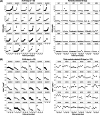Differentiation of stable kidney function versus progressive dysfunction in dogs
- PMID: 37861343
- PMCID: PMC10658543
- DOI: 10.1111/jvim.16885
Differentiation of stable kidney function versus progressive dysfunction in dogs
Abstract
Background: Circulating creatinine and symmetric dimethylarginine (SDMA) are biomarkers of kidney function that have been used variously to define stable vs progressive chronic kidney disease (CKD). Slope monitoring of inverse biomarker values (creatinine-1 or SDMA-1 ) has shown promise, but quantitative criteria to distinguish stable vs progressive CKD using this approach are lacking.
Objective: Assessment of creatinine-1 and SDMA-1 slope cutoffs to distinguish stable vs progressive CKD.
Animals: One hundred ten clinically healthy university staff-owned dogs and 29 male colony dogs with progressive X-linked hereditary nephropathy (XLHN).
Methods: Retrospective analysis combining 2 prospective observational studies, 1 tracking kidney function biomarkers in healthy dogs (HDs) to a maximum of 3 years, and 1 tracking kidney function biomarkers in male colony dogs with progressive XLHN to a maximum of 1 year. The minimum slope of creatinine-1 or SDMA-1 as measured using the IDEXX SDMA test from HD was assigned as the slope cutoff for stable kidney function.
Results: The stable vs progressive slope cutoff was -0.0119 week × dL/mg for creatinine-1 and -0.0007 week × dL/μg for SDMA-1 .
Conclusions and clinical importance: In the studied CKD population, progressive dysfunction can be distinguished from stable kidney function by using the slope of creatinine-1 or SDMA-1 . These criteria may serve to characterize CKD in other cohorts of dogs and to establish guidelines for degrees of progression rate in dogs with naturally occurring CKD.
Keywords: biomarker; creatinine; disease monitoring; inverse slope; symmetric dimethylarginine.
© 2023 The Authors. Journal of Veterinary Internal Medicine published by Wiley Periodicals LLC on behalf of American College of Veterinary Internal Medicine.
Conflict of interest statement
G. Farace, D. Szlosek, Z. Ouyang, S. Peterson, M. Beall, and M. Yerramilli are employed by and have stock or stock options with IDEXX Laboratories, Inc. L. D. Cowgill, G. Segev, S. Vaden, S. Ross, C. Dufayet, L. A. Cohn, M. Nabity, and D. Polzin have received travel reimbursement and honoraria from IDEXX Laboratories, Inc. within the past 5 years. Shelly Vaden serves as Associate Editor for the Journal of Veterinary Internal Medicine. She was not involved in review of this manuscript.
Figures




References
-
- International Renal Interest Society . IRIS staging of CKD. 2019.
-
- Mitch WE, Walser M, Buffington GA, Lemann J Jr. A simple method of estimating progression of chronic renal failure. Lancet. 1976;308(7999):1326‐1328. - PubMed
-
- Allen TA, Jaenke RS, Fettman MJ. A technique for estimating progression of chronic renal failure in the dog. J Am Vet Med Assoc. 1987;190(7):866‐868. - PubMed

